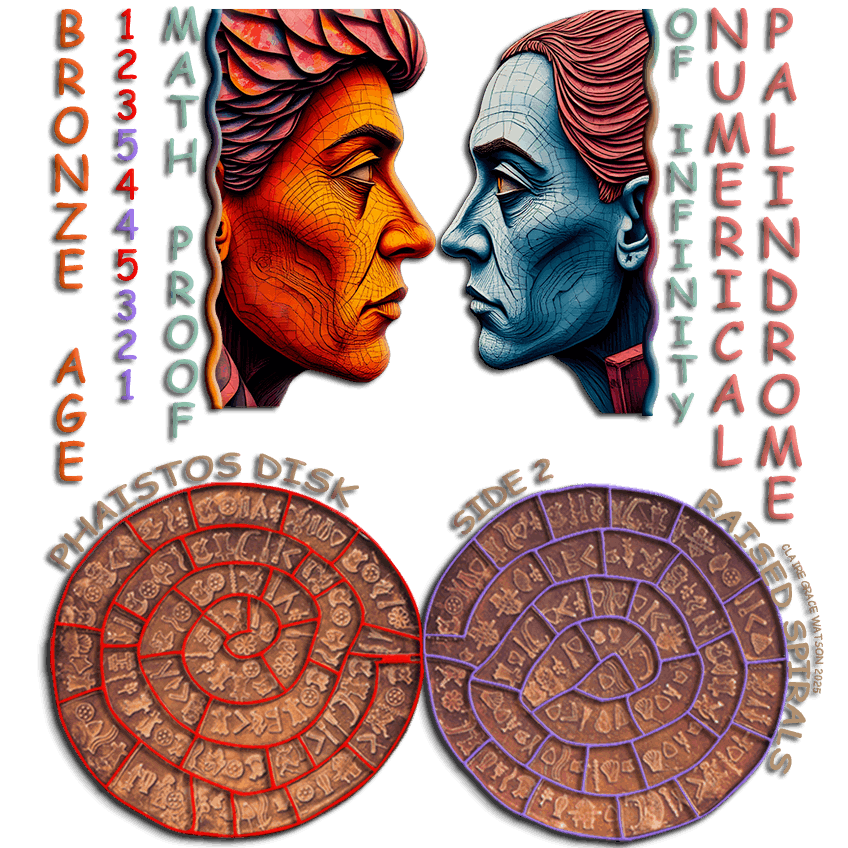
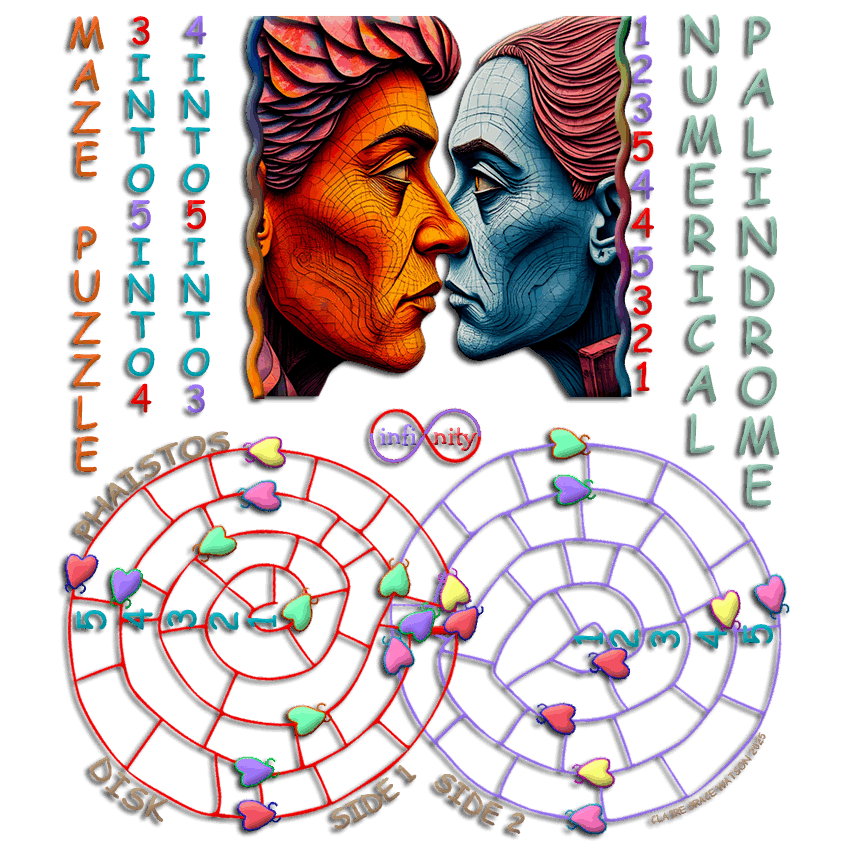
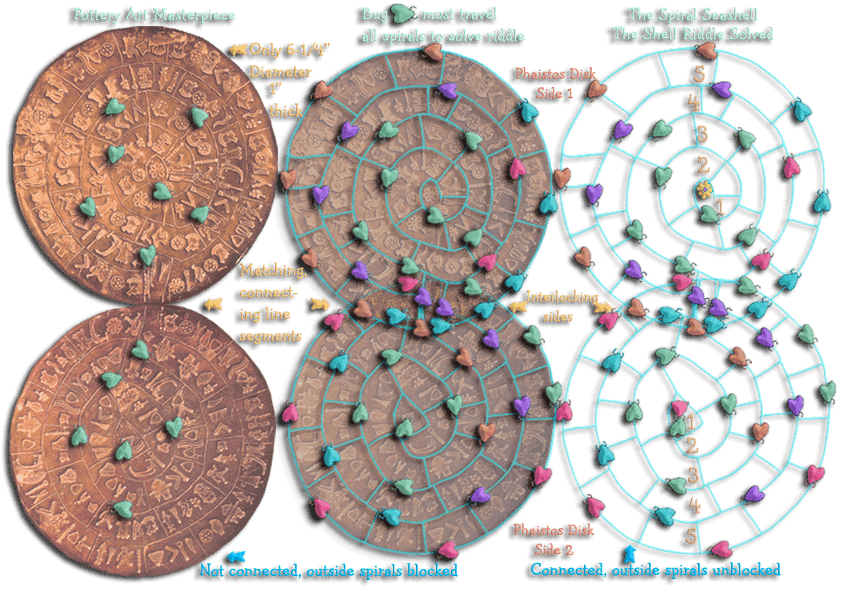
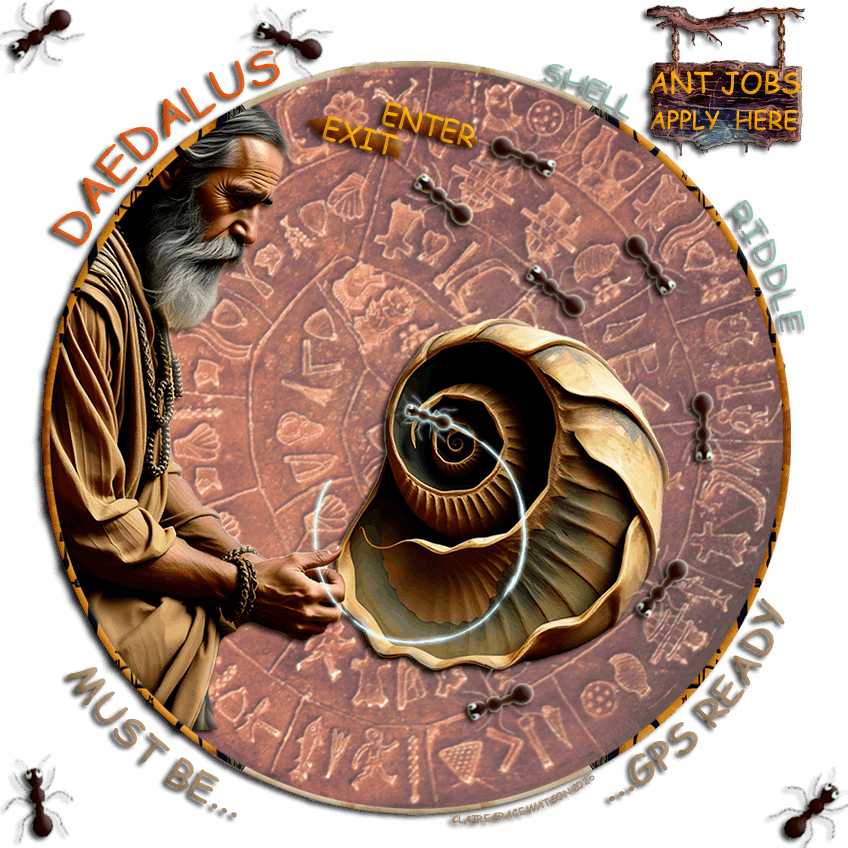
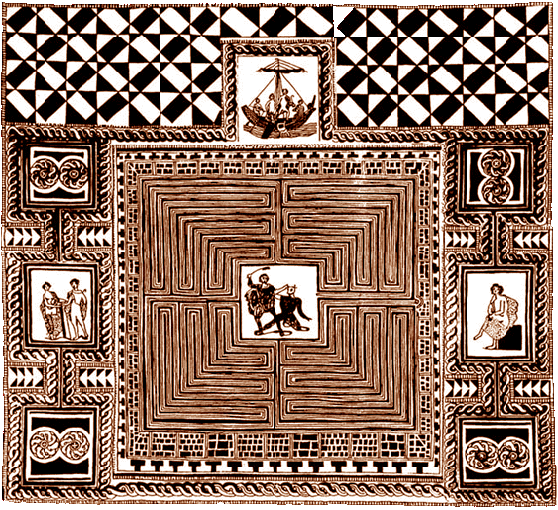
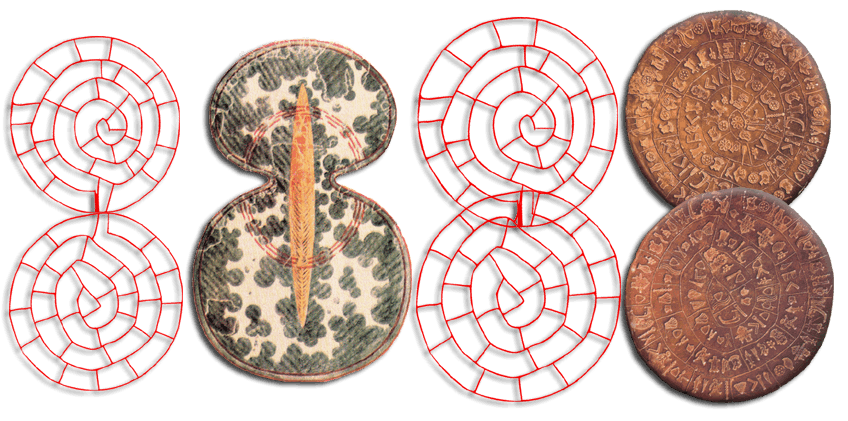
The two sides of the Disk (pictographs removed) placed side-by-side this way appear to be a maze. Minoan Crete was the maze civilization, with labyrinths in art and all the associated symbolism: the Double Axe,
On the Phaistos Disk, the outside spirals seem to circle around the center,
while the inside spirals curl in on themselves, and these words also describe the actions of a phi spiral and provide a clue to the solution of the maze. In these
phi spirals, both spirals spin the same direction until you start at the center of one and crossover, and this is exactly what happens on the Phaistos Disk. Then, the journey to the center of the other spiral becomes counter the direction of the first.
If the Phaistos Disk is the
Maze of Daedalus
, then the young Greeks cast into it were as doomed as the legend states. They were told they could avoid being eaten by the Minotaur if they could find their way out, but they would have been hopelessly lost because the spiral's direction is relative, leading only to dead ends. Their deaths were inescapable. Only a miracle could save them.
I found the wave spiral and solved the maze by removing the disk pictographs from transparencies I created so that only the
spirals and line segments were visible. Then I placed the two sides together at the matching line segments and merged them by overlaying the perfectly
aligned line segments.
The solution to a maze is the uninterrupted path through an intricate pattern of line segments from a starting point to a goal.
The Disk has a combined 60 line segments and two large spirals, each with five levels. The starting point of this maze is the center of Side 1 (top disk with flower at the center), the goal is the center of Side 2 (bottom disk with wave at the center). To solve the maze, find the uninterrupted path through the line segments of all the spirals, from the center of Side 1 to the center of side 2 and back.
Movement through the maze is simple. Start in the top center (try it, using this image on the left that's missing the pictographs) and spiral out counterclockwise then cross over to the center of Side 2 via the 4th level spiral, now moving clockwise, continue to the center then make the return journey in reverse. The matching,
connecting line segments direct the movement from Side 1 to Side 2 but also prevent travel in the outer
spirals on both sides. Move back and forth freely on these eight spirals, but the maze is not solved until all ten spirals are incorporated into this uninterrupted movement.
Start at the center of Side 1 and trace the spiral around counterclockwise to the 4th level as before, but this time the bridge directs the movement to the outer spiral on Side 2 as the movement changes to clockwise. Cross the bridge again from that outer spiral to the outer spiral on Side 1 now moving counterclockwise. Cross the bridge from the
outer spiral on Side 1 into the 4th spiral on Side 2 moving clockwise and travel to the center. Then make the same journey
in reverse, each time creating the pattern of a figure 8.
Phaistos Disk Hidden Pattern - Figure 8 Wave Spiral, Constellation, Maze Solution Pictographs removed, two sides connected
Applying Will Durant's advocation for "hazardous historical television", I imagine the Minoans sailed across the Aegean waves back and forth from Crete to Egypt to tour the Great Pyramid, that monumental feat of Bronze Age technology and the most popular tourist destination on the planet back then as it is now.
"Homer tells us, 'the dark-prowed ships are borne to Egypt by the force of the wind and the wave. 'The southbound trade of Minoan Crete pours out here, swelled by goods from northern merchants who ship their cargoes overland to avoid a long detour by perilous seas. (
The Life of Greece
, Will Durant, 1939)
There seems to me to be a connection between (1) the identification and naming of constellations by the Minoans; (2) their apparent access to the pyramid, perhaps for astronomy and/or religion, represented by the explicit images on the Disk of their exploration of the pyramid, in combination with the constellation Argo seen on the Disk; (3) the Minoan boat on the Disk and the Minoans' advanced nautical technology and navigational skills, represented by the North Star image on the Disk, and; (4) their apparent travel to the pyramid from many foreign ports in the Aegean, not just ports in Crete.
Early astronomy involved the study of the properties of a circle and the geometry of a sphere, for use in astronomy. This involves the antique science of
"containment of geometrical arrangements,"
nearly lost now but building pyramids and civilizations way back then. I think the Disk preserves not only the cultural relationship of the Minoans with Egypt and the Great Pyramid but also preserves part of this ancient science that may have been used in the construction of the Great Pyramid.
Whoever created the Phaistos Disk (and fire-hardened it to preserve it) must also have been knowledgeable about this ancient science and might therefore have been the da Vinci of that world. Such a person from that time exists in myth, known to us as Daedalus, a visionary and the world's most famous inventor. If Daedalus created the Phaistos Disk or invented it and commissioned a brilliant artist to create it, this could be another invention of Daedalus or it could be the renown Maze of Daedalus.
Phaistos Disk pictograph, Runner,
The Phaistos Disk will test your beliefs about the universe. Do you believe in the Big Bang universe or do you believe in the Intelligent Design universe? Can the universe be both? The mind searches for evidence of your beliefs as it seeks patterns in chaos. Does it find them? Try searching the Phaistos Disk for patterns!
"Daedalus (=cunning artificer) was a sort of personified summary of mechanical skill." (H.G. Wells)
Centuries passed and the legendary status of Daedalus the inventor grew. The stories surrounding him became unrelated
to his inventions, but beyond inventing a maze, a bedchamber, wings and images, Daedalus cannot be said to have invented anything that
would justify his extraordinary status as the world's greatest inventor. The invention of images, however, would certainly qualify this
inventor for legendary status, but it seems his reputation rests on his most famous invention, the Maze of Daedalus, which is lost in time.
We have only mythology to tell us what his maze was and what its purpose was, but mythology is storytelling of the highest order and not
recorded history at all. We just know he invented an incredible maze in Crete during a period of time before written history.
Had he invented a way of recording a history of his time, so that he could record some of the events and some of his inventions,
that would be very helpful, but he also would have to invent a way to do it and a way to preserve it for thousands of years. If he was truly
worthy of his legendary status as inventor, he would have done that. This cunning artificer could invent not just the thing itself but the way to
make it, as well. The Phaistos Disk could be his greatest invention, the one for which he is best known and which records his other inventions
including how he made it and why he is credited with inventing images.
The Phaistos Disk may not be the Maze of Daedalus, but nothing will ever come as close to it as this disk. I am also encouraged
to embrace this theory because it is so much easier to talk about the Phaistos Disk if we allow it to be the Maze of Daedalus and if we interpret
the mythology of Daedalus literally and allow that he actually lived in Minoan Crete. And he must have, for how else could he have known about all these calendars and how they all work together?
In addition to hidden patterns, the Phaistos Disk may preserve an ancient calendar with multiple uses. The Disk might be a zodiac stellar calendar based on star groups. Star groups might be arranged in groups of 12,
along the outer edge in the same location as the lunar months. These might be the 12 constellations we are familiar with today that are generally accepted as identified by Minoan
Crete. 18 more spiral out from the center of Side 1 and Side 2, for a total of 36 groups or decans, each one rising above the dawn
horizon for 10 days, totaling 360 days. The star groups spiral into the center as they begin their move into the underworld of Tartarus/Hades
(go below the horizon) for 70 days/signs before they appear again.
18 star groups spiral into the center (18 line segments of the inner spirals) as they move into the underworld of Tartarus/Hades (go below the horizon) for 70 days before they reappear. 70 is the exact number of pictographs, beginning at the crossover from Side 1 to Side 2, countingfrom the first pictograph met with in spiral 4, the dog, "dog star," an ancient symbol for Sirius. Therefore, each one of these pictographs represents a day in which the star Sirius, seen rising with the sun on Side 1, has now disappeared from the sky on Side 2. Heliacal rising of Sirius will occur again at the flower on Side 1 in an infinite cycle, as represented by the infinity symbol created when the two sides of the Disk are joined together at the matching, connecting line segments.
Observation of the
movement of star groups would let the Minoans tell time at night because the decans would rise 40 minutes later each night. When reckoning time at
night, only 12 decans (and annual divisions) were used (our signs of the zodiac), delineated by the 12 line segments along the edge of the Disk, although 18 were taken into account, those delineated in the center of the
Disk by the 18 line segments. With the addition of a 10 day intercalary month every two years, a 365-night stellar year can be accounted for.
Set these calendars to the first sighting of Sirius each year to keep them current. The Sothic (Sirius) year lasted from one
sighting of Sirius in the dawn of a new year until the next year on the same day. With these calendars working together, and with Oceanus, the World Ocean encircling the world (the wave
spirals below) and connecting these calendars together in a neverending wave spiral, infinity is accounted for, represented by the infinity symbol created by interlocking both sides of the Disk.
Long after the Phaistos Disk was created, the Greeks gave the name Helios to the god of the measurement of time. He had several sister goddesses called Horae, goddesses of the cycles of Time who reigned over the revolution of the constellations by which the passing seasons were measured. The Horae were honored by farmers, who would hoe the ground, plant and tend their crops according to
the location of the stars in the skies. (The Horae, right, hold pomegranates/stars, and left on the Disk.) Because the Horae surrounded the throne of Helios, this method of
timekeeping is a heliocentric horae-scope or horoscope, meaning to observe time or the seasons.
This method of keeping "star" time might point to the Sothic calendar, a wide-spread
Egyptian method of keeping time by tracking the star Sirius instead of the sun. The matching shield pictographs on side 1 when connected reveal a pentagram inside a heptagon, perhaps the star Sirius surrounded by the seven planets. This might indicate the Minoan use of a Sothic calendar.
Mathematics is apparent on the Disk, and we can discover Mediterranean Bronze Age concepts of mathematical symmetry just by counting the pictographs, the spirals, and the line segments. The Phaistos Disk is terracotta pottery, about 6-1/4" diameter, a bit larger than a CD, with 2 inscribed sides and 2 spirals per side, each spiral with 5 rings (10). The spirals are divided into 60 line segments (30 Side 1, 30 Side 2). The outside spirals have 12 line segments (24 outside); inside spirals have 18 (36 inside). Divided among the line segments and etched into the the Disk are 48 unique miniature pictographs, most of them repeated to create 240 pictographs. 37 are created to appear identical and are repeated various times. 11 are unrepeated.
If the two sides of the Phaistos Disk have application as Minoan integrated calendars, taken together they might be a
Lunisolar calendar with 12 months and, every two years, the periodic intercalation of a 13th month, the interlinking line segments.
Side 1, the solar calendar, keeps track of the three seasons, each of four months duration, along the 12 line segments of the outer edge.
A count of the daylight hours or divisions of each day could also be kept on this side of the Disk, counting 12 divisions/hours along the
outside edge with the 12 months and the seasons of the year.
Side 2, the lunar calendar, keeps time in lunar months (moonths), a moonth being the time between the four phases of
the moon - new, waxing, full and waning. The lunar calendar has 12 moonths of 30 days for a 360-day year. The first month and new year might
begin in the summer on the heliacal rising of star Sirius in 1600 BCE, approximately the equivalent of our July 1. Alternately, the Minoans may
have had 30 months of 12 days – the 30 line segments each side, 12 of them on the outside spiral. Every two years the 13th month would occur and
it would be only 2 days shorter than the others.
The combined Lunisolar calendar might have worked this way; one month solar, one month lunar, moving from side to
side of the Disk, until 24 months had passed, at which time the intercalary or 13th month would begin the biennial festival of Dionysus in
Minoan Crete in which the drama of his life was re-enacted.
When did the first logic of infinity occur to us collectively and when was it first represented as a horizontal figure 8? Could it have been during the Minoan civilization? The integrated calendars may not have been intended to work this way, but if we wanted to keep time in these different ways we could if we
had the Phaistos Disk. And we could even have a Sothic calendar.
Sothic is the Greek word for Sirius, which the Egyptians called Sopdet or Sopdu. A Minoan
calendar/Phaistos Disk would be unique in that it may have solved the problem of keeping accurate time when tracking star Sirius.
All Sothic calendars were known to have 12 months of 30 days. Some Sothic calendars may have had 30 months of 12 days.
Both presented the Egyptian timekeepers with a problem -- a year of 360 days -- so they had to add 5 days at the end of the year to have a 365-day year so
that the calendar would work right.
The Egyptians had a whole mythology that went with these 5 extra days/gods, which were festival days in Egypt and perhaps Crete,
when the birth of these gods was celebrated. With the extra 5 days added, the Egyptian Sothic calendar would start again the following year
on or about the same important day -- the heliacal rising of Sirius -- the day the star first rises with the sun. But the Sothic cycle was 1468 years because that is how long it takes for the calendar to recoup that day that was lost every 4 years from having a 365 day year.
The Phaistos Disk may be a Sothic calendar that keeps accurate star time, and it
may be the only physical one in existence. There may be something unique about this Sothic calendar. Instead of having 12 months of 30 days, it
may have alternating months of 30 and 31 days, (counting the connecting line segment as a day of the month rather than an intercalary month) more
like our calendar than like the Egyptian calendar. Around the outside edge of the Disk are the 12 solar and the 12 lunar months. The solar months have 31 days and the lunar months have 30 days. The 2-sided Disk/calendar
represents a two-year period, at the end of which was held the festival of Dionysus in which his life was celebrated.
This method of keeping time would be incredible if you consider what is known about Sothic calendars. It means that the Minoans may
have figured out how to adjust a Sothic calendar so it kept proper star time and avoided the "Sothic cycle" of 1468 years.
When you look at our calendar you see something odd about it. The months don't alternate 30 and 31 days
every time, and February has only 28 days. Then, every four years we add a day to make up for the fact that our year is really 365 and 1/4 days,
and that ends our cycle. Our calendar is only off by a 1/4 of a day each year and we are
unaffected by that as long as we correct periodically.
The Minoans may have taken exactly the same approach. The difference is, while the Egyptians had years of 360 days and we have years
of 365 days, the Minoans may have had years of 366 days. Rather than add 5 days at the end of the year and then have a calendar that rights itself
every 1468 years, the Minoans may have had alternate months of 30 and 31 days. Then, they subtracted a day at the end of every two years, and that kept them
within a 1/2 day of accuracy and ended their cycle. Instead of adding 5 festival days at the
end of the year, like the Egyptians and their civil calendar, they may have celebrated them along with the Egyptians as festival days that occurred for them at the beginning of their
year with the heliacal rising of Sirius. Then, every 2 years they held their own festival of Dionysus on the "subtracted" day, a day that didn't exist at all because it wasn't on their calendar - perfect for a wild, Dionysian bacchanal!
By their subtraction method of timekeeping, the Minoan calendar would be simple and correct. If it really worked this way it would have given them a huge
advantage over the rest of the Aegean world and might explain in part their fantastic civilization. Their calendar would always have been a little ahead
instead of a lot behind. Additional to their world view might have been the enlightened idea that time and the stars are dieties we can shape, using our imagination and the tools of geometry, to become more than mere subjects of them.
"A...method is used by Claire Grace Watson (Phaistos Disk Literature and Art), to analyze the Phaistos disk to form a Minoan shield resembling the Roman anciles."
"I think you have decoded The Phaistos Disk!" (Adolfo Rios Pita Giurfa, giurfa.com)
![]() the Figure 8 Shield,
the Figure 8 Shield,  the Minoan Wave Spiral.
the Minoan Wave Spiral. ![]() Minoans saw something profound about a maze, and from their civilization at exactly the same time as the Phaistos Disk came the legendary Maze of Daedalus. We might be looking at it.
Minoans saw something profound about a maze, and from their civilization at exactly the same time as the Phaistos Disk came the legendary Maze of Daedalus. We might be looking at it. ![]()
![]() This Phaistos Disk pictograph suggest a solution to the maze puzzle.
Below, my exact tracing of the Phaistos Disk Maze of Daedalus.
This Phaistos Disk pictograph suggest a solution to the maze puzzle.
Below, my exact tracing of the Phaistos Disk Maze of Daedalus.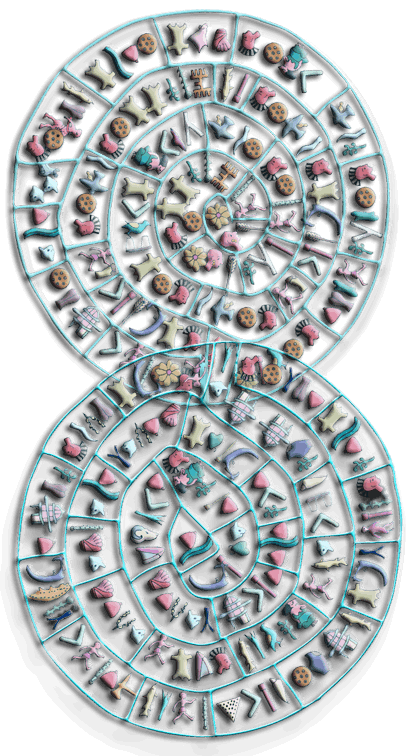 To solve the maze, incorporate the outer spirals by merging them. Overlap the matching, connecting line segments by placing
the bottom image onto the top image to create a bridge. With all ten spirals
connected and the figure 8 created, the maze can be traversed via the bridge in an uninterrupted movement through all the spirals and thus is solved.
To solve the maze, incorporate the outer spirals by merging them. Overlap the matching, connecting line segments by placing
the bottom image onto the top image to create a bridge. With all ten spirals
connected and the figure 8 created, the maze can be traversed via the bridge in an uninterrupted movement through all the spirals and thus is solved.
![]()
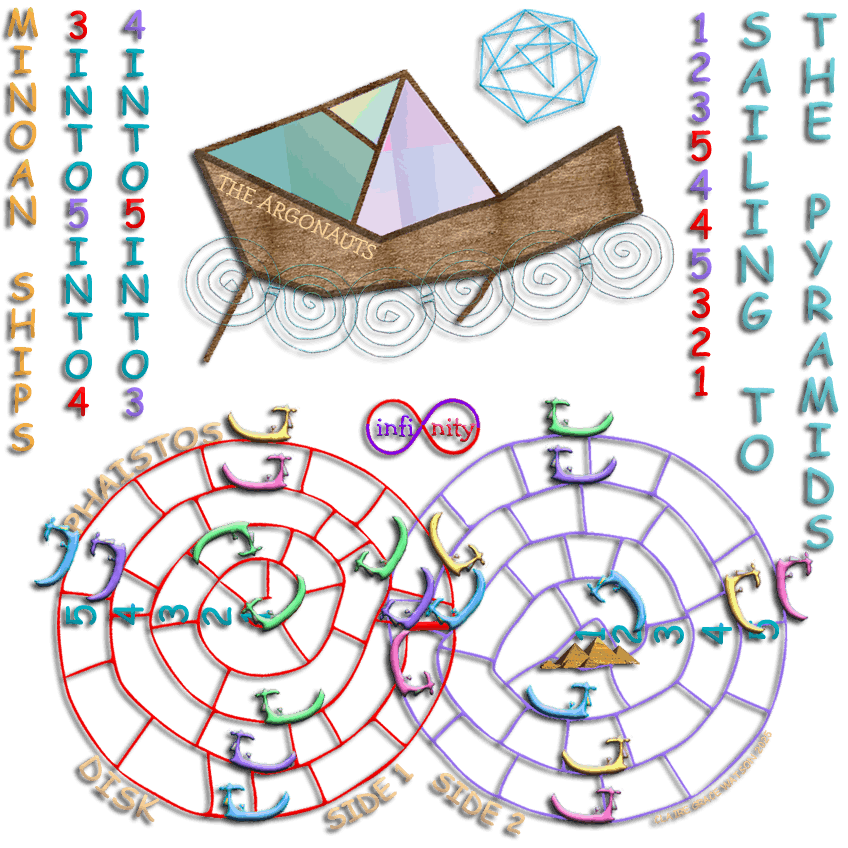
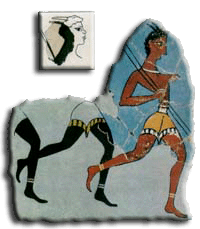



compared with Minoan mural of runners![]()
![]()

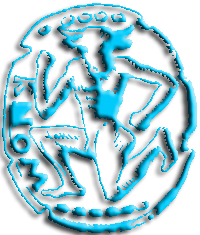 It is difficult, when
reading all the mythology and legends associated with Daedalus, to state exactly what the world's greatest invertor invented. A list of his inventions begins with a lurid tale that
Greek adults perhaps told in saunas to pass the time. Poseidon, god of the sea and special god of Plato's Atlantis, presented King Minos
with a white bull and Queen Pasiphae with a problem, which Daedalus solved. The king's wife is supposed to have lusted
after the bull! Pasiphae asked Daedalus, the palace architect, to design a bed
for the mating to take place. Daedalus complied and the result of the mating was the Minotaur, half-bull, half-human (right).
It is difficult, when
reading all the mythology and legends associated with Daedalus, to state exactly what the world's greatest invertor invented. A list of his inventions begins with a lurid tale that
Greek adults perhaps told in saunas to pass the time. Poseidon, god of the sea and special god of Plato's Atlantis, presented King Minos
with a white bull and Queen Pasiphae with a problem, which Daedalus solved. The king's wife is supposed to have lusted
after the bull! Pasiphae asked Daedalus, the palace architect, to design a bed
for the mating to take place. Daedalus complied and the result of the mating was the Minotaur, half-bull, half-human (right). ![]() Daedalus also invented the maze in which
innocent young Greeks were fed to the Minotaur wherein they wandered lost until eaten. In another variation of the purpose of his maze,
he built it for King Minos of Crete in order to contain the Minotaur, who was the queen's son. He also is credited with inventing attachable
feathered wings, held together with strings and wax, so that humans could fly (pictograph left). With these wings he
and his son Icarus escaped his own inescapable maze by flying out of it. When Icarus flew too high, the sun melted the wax.
Daedalus also invented the maze in which
innocent young Greeks were fed to the Minotaur wherein they wandered lost until eaten. In another variation of the purpose of his maze,
he built it for King Minos of Crete in order to contain the Minotaur, who was the queen's son. He also is credited with inventing attachable
feathered wings, held together with strings and wax, so that humans could fly (pictograph left). With these wings he
and his son Icarus escaped his own inescapable maze by flying out of it. When Icarus flew too high, the sun melted the wax.
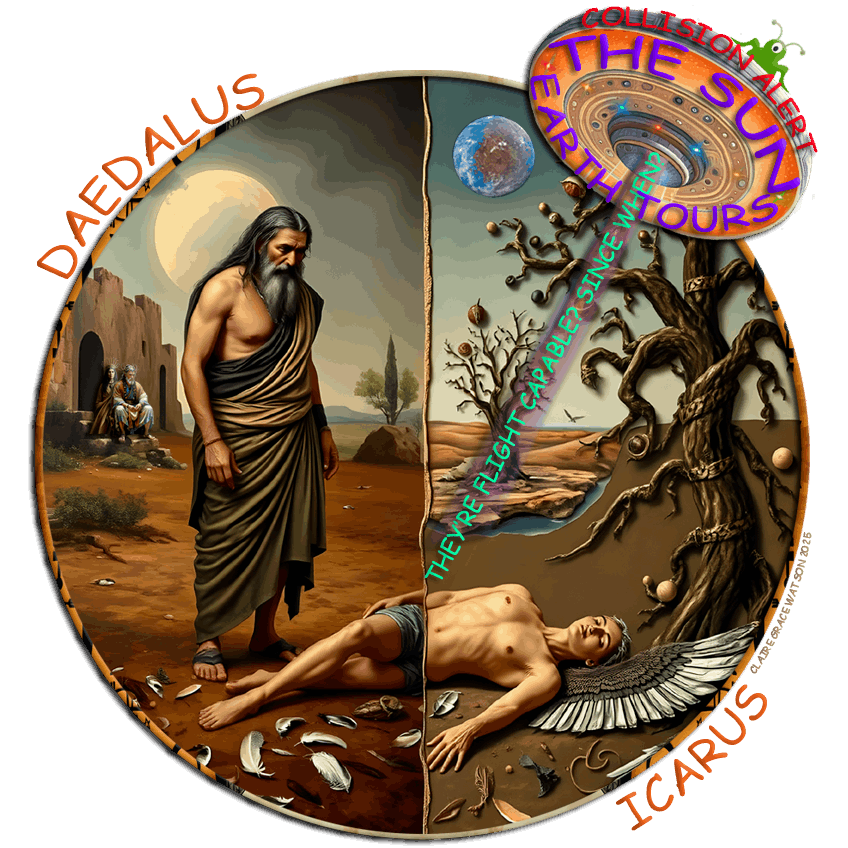
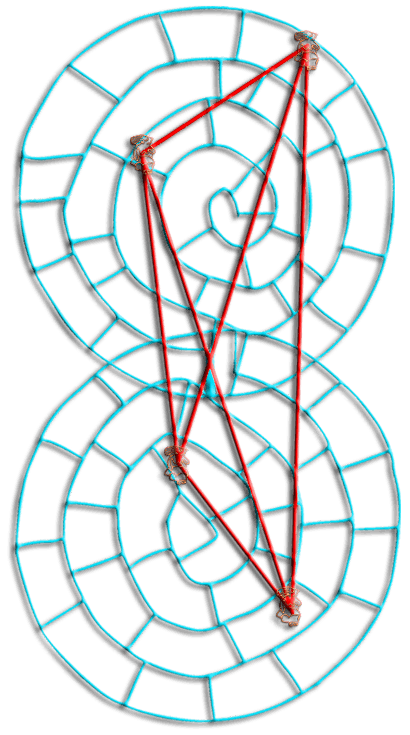 If the Phaistos Disk is the Maze of Daedalus, then the great inventor deserves his star status and more because the disk may
record his inventions that seem now lost to us. They included images, telescopes, binoculars, textbooks in clay, calendars, a printing press, a kiln, mazes, an historical record,
geometries, constellations, world-disks, and even a new world-view of an old world. He may also have realized spatial relativity and created an
object to demonstrate it( left). If so, it has taken nearly 4,000 years for his inventions and ideas to become known because that is about how long
the Phaistos Disk was lost.
If the Phaistos Disk is the Maze of Daedalus, then the great inventor deserves his star status and more because the disk may
record his inventions that seem now lost to us. They included images, telescopes, binoculars, textbooks in clay, calendars, a printing press, a kiln, mazes, an historical record,
geometries, constellations, world-disks, and even a new world-view of an old world. He may also have realized spatial relativity and created an
object to demonstrate it( left). If so, it has taken nearly 4,000 years for his inventions and ideas to become known because that is about how long
the Phaistos Disk was lost.
![]()

![]()
![]()
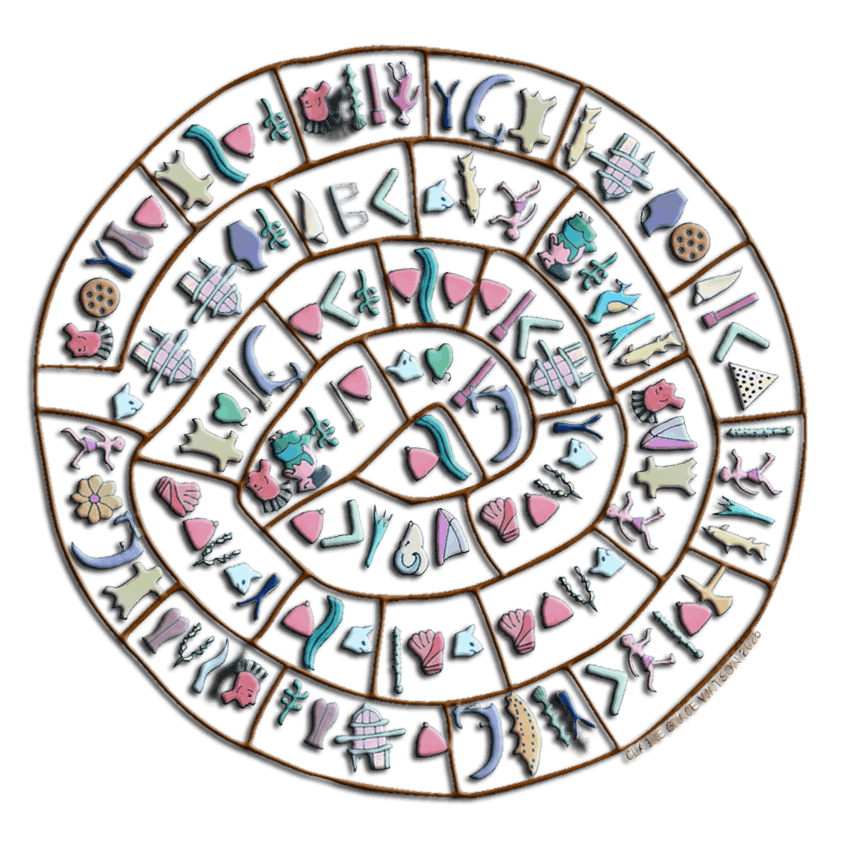
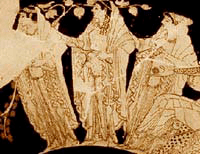
 In the Egyptian sense, it is SIRIUS the Dog-Star, the Star or Isis-Sothis. Around it are the Stars of the Seven Planets each with its seven-fold counterchanged operation. (Israel Regardie, The Golden Dawn, re: pentagram inside heptagon design in mysticism)
In the Egyptian sense, it is SIRIUS the Dog-Star, the Star or Isis-Sothis. Around it are the Stars of the Seven Planets each with its seven-fold counterchanged operation. (Israel Regardie, The Golden Dawn, re: pentagram inside heptagon design in mysticism)
![]()
![]()
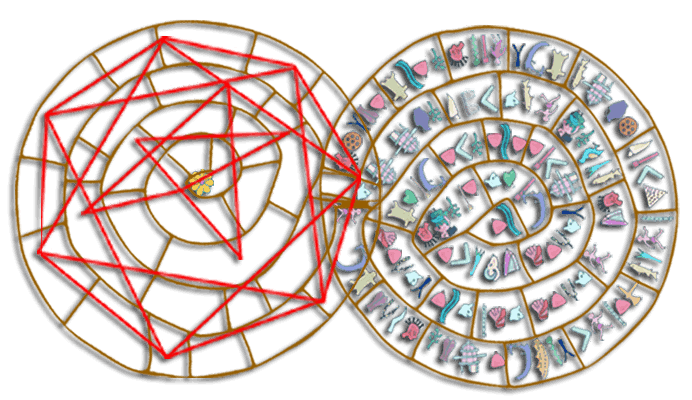
![]()
 Sirius rose with the sun on about the same day every year, July 19th, the sun perhaps represented by the 8-petaled "Flower" at the center of Side 1. Just like we add one day in February every leap year to
make our calendar and our sun work in conjunction, the Egyptians added 5 days at the end of their year and tracked the movement of a star
rather than the sun. The star's movement is so close to that of the sun that the star calendar worked the same as a sun calendar. One is a
lunar calendar and the other is a solar calendar.
Sirius rose with the sun on about the same day every year, July 19th, the sun perhaps represented by the 8-petaled "Flower" at the center of Side 1. Just like we add one day in February every leap year to
make our calendar and our sun work in conjunction, the Egyptians added 5 days at the end of their year and tracked the movement of a star
rather than the sun. The star's movement is so close to that of the sun that the star calendar worked the same as a sun calendar. One is a
lunar calendar and the other is a solar calendar.
![]()
![]() Just as night follows day, night perhaps represented by the "Star" at the center of Side 2, the Egyptians and perhaps the Minoans had calendars with
solar months and lunar months. Before electricity and without bright lights to obscure the night sky, our relationship with it was much more intimate than it is today.
Just as night follows day, night perhaps represented by the "Star" at the center of Side 2, the Egyptians and perhaps the Minoans had calendars with
solar months and lunar months. Before electricity and without bright lights to obscure the night sky, our relationship with it was much more intimate than it is today.
![]()
![]()
![]()
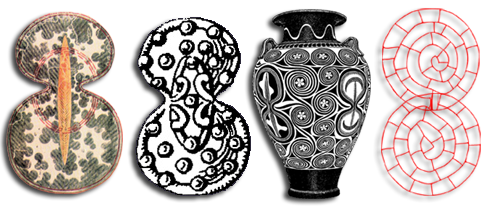 Minoan vase with Phaistos Disk similarities
Minoan vase with Phaistos Disk similarities
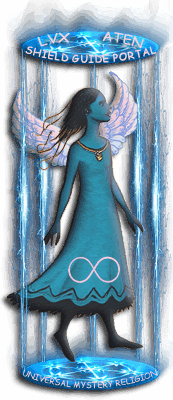 Copyright Notice - Disk of the World - Text and images copyrighted March 21, 1993-2025, Claire Grace Watson, B.A., M.S.T., U.S. Copyright and under the Digital Millennium Copyright Act of 1998, All rights reserved. No part of this web page may be reproduced or transmitted in any form or by any means without written permission from the author, except for the inclusion of brief quotations in a review.
Copyright Notice - Disk of the World - Text and images copyrighted March 21, 1993-2025, Claire Grace Watson, B.A., M.S.T., U.S. Copyright and under the Digital Millennium Copyright Act of 1998, All rights reserved. No part of this web page may be reproduced or transmitted in any form or by any means without written permission from the author, except for the inclusion of brief quotations in a review.